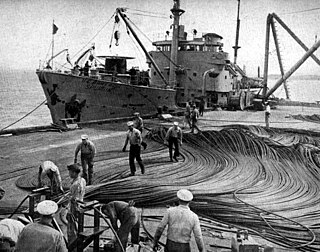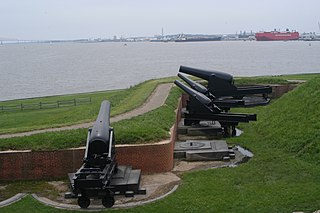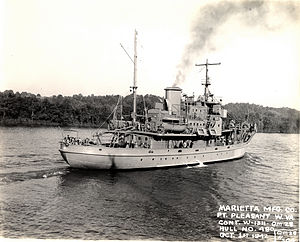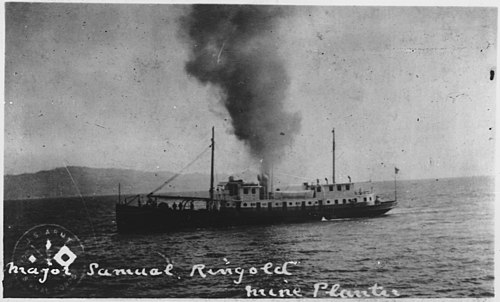
The USCG seagoing buoy tender is a type of United States Coast Guard cutter originally designed to service aids to navigation throughout the waters of the United States, and wherever American shipping interests require. The U.S. Coast Guard has maintained a fleet of seagoing buoy tenders dating back to its origins in the U.S. Light House Service (USLHS). These ships originally were designated with the hull classification symbol WAGL, but in 1965 the designation was changed to WLB, which is still used today.

In the United States Armed Forces, the ranks of warrant officer are rated as officers above all non-commissioned officers, candidates, cadets, and midshipmen, but subordinate to the lowest officer grade of O‑1. This application differs from the Commonwealth of Nations and other militaries, where warrant officers are the most senior of the other ranks, equivalent to the US Armed Forces grades of E‑8 and E‑9.
USS Barricade (ACM-3) was a Chimo-class minelayer in the United States Navy during World War II.

USS Barbican (ACM-5) was a Chimo-class minelayer in the United States Navy. Barbican was later commissioned in U.S. Coast Guard as USCGC Ivy.
USS Obstructor (ACM-7) was a Chimo-class minelayer in the United States Navy during World War II.

USS Picket (ACM–8) was a Chimo-class minelayer of the United States Navy during World War II.

USCGC Yamacraw (WARC-333) was a United States Coast Guard Cable Repair Ship. The ship was built for the Army Mine Planter Service as U. S. Army Mine Planter Maj. Gen. Arthur Murray (MP-9) delivered December 1942. On 2 January 1945 the ship was acquired by the Navy, converted to an Auxiliary Minelayer and commissioned USS Trapper (ACM-9) on 15 March 1945. Trapper was headed to the Pacific when Japan surrendered. After work in Japanese waters the ship headed for San Francisco arriving there 2 May 1956 for transfer to the Coast Guard.
Monadnock (ACM-14) was originally built as an M1 mine planter for the U.S. Army Coast Artillery Corps, Mine Planter Service as USAMP Major Samuel Ringgold by the Marietta Manufacturing Co., Point Pleasant, WV and delivered to the Army December 1942. The ship was named for Samuel Ringgold (1796–1846), an officer noted as the "Father of Modern Artillery" that fell in the Mexican–American War.

USS Miantonomah (ACM-13/MMA-13) was built as the US Army Mine Planter USAMP Col. Horace F. Spurgin (MP-14) for the U.S. Army by Marietta Manufacturing Co., Point Pleasant, West Virginia, in 1943. Col. Horace F. Spurgin was christened by Mrs. Barbee Rothgeb. Col. Horace F. Spurgin was transferred from the US Army to the US Navy and commissioned as ACM-13 on 25 January 1950. After decommissioning and sale to commercial interests 17 February 1961, the ship remained in the fishing fleet into the 1990s before becoming part of a breakwater in Tacoma, Washington.

Puritan (ACM-16/MMA-16) was built for the United States Army as U.S. Army Mine Planter (USAMP) Col. Alfred A. Maybach MP-13. The ship was transferred to the United States Navy and classified as an auxiliary minelayer. Puritan was never commissioned and thus never bore the "United States Ship" (USS) prefix showing status as a commissioned ship of the U.S. Navy.

Seacoast defense was a major concern for the United States from its independence until World War II. Before airplanes, many of America's enemies could only reach it from the sea, making coastal forts an economical alternative to standing armies or a large navy. After the 1940s, it was recognized that fixed fortifications were obsolete and ineffective against aircraft and missiles. However, in prior eras foreign fleets were a realistic threat, and substantial fortifications were built at key locations, especially protecting major harbors.

USAMP Major General Wallace F. Randolph, sometimes also known as MG Wallace F. Randolph, was a 188.2-foot (57.4 m) mine planter built by the Marietta Manufacturing Company, and delivered to the United States Army Mine Planter Service in 1942. The ship was transferred to the U.S. Navy in 1951, placed directly into the Atlantic Reserve Fleet without being commissioned classed as the auxiliary minelayer ACM-15, then reclassified minelayer, auxiliary (MMA) and named MMA-15, and finally given the name Nausett without any active naval service. After being stricken from the Naval Vessel Register, the ship was transferred to different owners, and eventually was scuttled off the coast of Florida as an artificial reef and fish aggregating device. The site is currently known as the Thunderbolt Wreck, and is considered to be an excellent and challenging dive site for advanced divers.
A controlled mine was a circuit fired weapon used in coastal defenses with ancestry going back to 1805 when Robert Fulton termed his underwater explosive device a torpedo:
Robert Fulton invented the word torpedo to describe his underwater explosive device and successfully destroyed a ship in 1805. In the 1840s Samuel Colt began experimenting with underwater mines fired by electric current and in 1842, he blew up an old schooner in the Potomac River from a shore station five miles away.
Camanche (ACM-11/MMA-11) was the name given in 1945 to the former U.S. Army Mine Planter (USAMP) Brigadier General Royal T. Frank (MP-12) while in naval inactive reserve more than ten years after acquisition of the ship by Navy from the Army in 1944. The ship had previously been classified by the Navy as an Auxiliary Mine Layer (ACM) and then Minelayer, Auxiliary (MMA). The ship was never commissioned by Navy and thus never bore the "USS" prefix.

Mine planter and the earlier "torpedo planter" was a term used for mine warfare ships into the early days of World War I. In later terminology, particularly in the United States, a mine planter was a ship specifically designed to install controlled mines or contact mines in coastal fortifications. This type of ship diverged in both function and design from a ship operating as a naval minelayer. Though the vessel may be seagoing it is not designed to lay large numbers of mines in open sea. A mine planter was designed to place controlled minefields in exact locations so that they might be fired individually or as a group from shore when observers noted a target to be at or near a designated mine's position. The terms and types of specialized ship existed from the 1860s where "torpedoes" were made famous in the American Civil War until the demise of large, fixed coastal fortifications brought on by the changes of World War II.

The modern era of defending American harbors with controlled mines or submarine mines began in the post-Civil War period, and was a major part of US harbor defenses from circa 1900 to 1947.

The U.S. Army Coast Artillery Corps (CAC) was an administrative corps responsible for coastal, harbor, and anti-aircraft defense of the United States and its possessions between 1901 and 1950. The CAC also operated heavy and railway artillery during World War I.
USCGT Acacia (WAGL-200) was originally built for service by the U.S. Army as a mine planter shortly after World War I and later transferred to the U.S. Lighthouse Service, which became part of the U.S. Coast Guard in 1939; when transferred the ship was redesignated as a Speedwell-class buoy tender. She was sunk in 1942 by a German U-boat.










